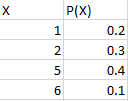1- Consider the following probability distribution table: X P(X) 0.2 0.3 5 0.4 6 0.1 Assume that a sample of n=2 measurements is selected from the population. a. List all the different values that the sample median (m) may assume and find the probability for each of them. b. Find the sampling distribution (probability distribution table) of the sample median. c. Find the mean of the sampling distribution of the median. Is it an unbiased estimator of the population mean (mean of X)?
Continuous Probability Distributions
Probability distributions are of two types, which are continuous probability distributions and discrete probability distributions. A continuous probability distribution contains an infinite number of values. For example, if time is infinite: you could count from 0 to a trillion seconds, billion seconds, so on indefinitely. A discrete probability distribution consists of only a countable set of possible values.
Normal Distribution
Suppose we had to design a bathroom weighing scale, how would we decide what should be the range of the weighing machine? Would we take the highest recorded human weight in history and use that as the upper limit for our weighing scale? This may not be a great idea as the sensitivity of the scale would get reduced if the range is too large. At the same time, if we keep the upper limit too low, it may not be usable for a large percentage of the population!

Consider the following table-

sample size = n = 2
Trending now
This is a popular solution!
Step by step
Solved in 3 steps with 2 images









